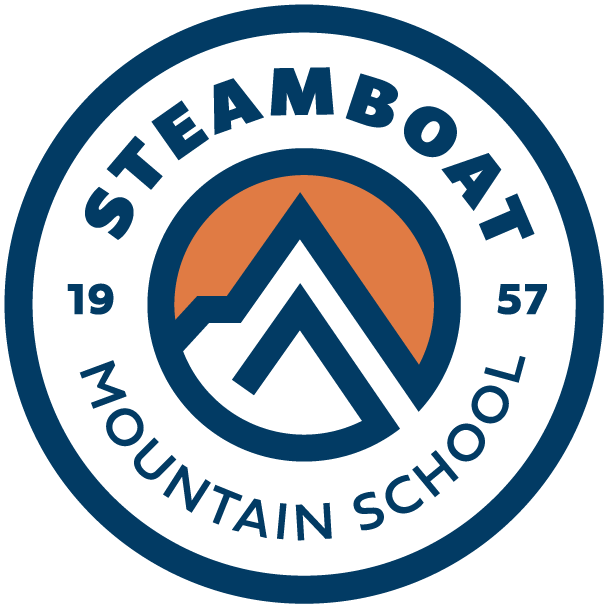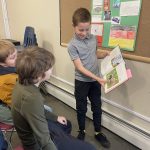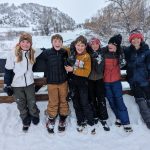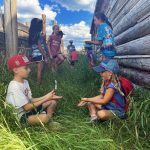We love his-tor-y! We love history!
Mountain Connection: September 26th, 2023
By: Jed Donnel
Joanie’s U.S. History class is high energy. She is upbeat, energetic, and humorous by nature (the sort of glowing attributes that, for me, require the consumption of a couple of cups of coffee to begin to conjure). So, even as they walk into the room, her students know (and enjoy) the expectation that they’ll adjust their own moods in accordance. During the passing period before the actual lesson even began, Joanie strolled the room in myriad conversations, greeting individuals as they entered and fluidly altering the subject matter to account for everyone as they found their seats. While chanting, ‘We. Love. His-tor-y, we love history!” in the mode of a single-handed cheer squad, she would interrupt herself to ask kids about their weekend plans, who may attend the school bowling trip, offer them high-fives, and reveal the conspiracy she had recently hatched with Ted, who had planted a speaker in Cody’s room, to pipe in Red Hot Chili Peppers songs via bluetooth at random moments in a game of friendly, innocuous torture among colleagues. In short, you need to bring your energy to Joanie’s lessons, and if you arrive a bit sleepy, you need to find your energy quickly. The students certainly did so, successfully feeding off of her energy, which made for a lively, dynamic, and thoughtful lesson.
Subject matter for the course centers on ‘origins of the American U.S.’ and Joanie is currently guiding students in finding links between seemingly disparate sources, even across centuries and vast geographies. This is not a traditional history course taught in linear fashion. Rather, class opened with presentations from two students to cap off their recent research projects regarding current events related to the U.S. Constitution. Topics varied across similar presentations last week, though these two happened to both be about abortion rights and restrictions stemming from the Dobbs v. Jackson Women’s Health Org case decided by the Supreme Court in June 2022. The room split in half, and two sets of students migrated to different areas in the room so that both students could present simultaneously, while Joanie and Ted migrated back and forth. Emphasis was placed on objectivity, specificity, and expanded perspectives as the students presenting noted the key facts of the case, relevant wording used by the Court in rendering its decision, how the ruling differed from Roe v Wade in 1973, the differing perspectives within the Court today that may account for the different ruling, along with suppositions for what the Dobbs outcome may mean for the future. One student noted, for example, that in its ruling the Court stated, “The Constitution makes no reference to abortion and no such right is implicitly protected by any Constitutional provision,” which led her to consider the possibility of other rights currently protected but that are not specifically mentioned in the Constitution perhaps becoming matters for later court decisions. Likewise, she noted the fact that most Supreme Court rulings have historically afforded more or expanded rights to citizens, whereas the Dobbs ruling was unusual for restricting rights. The audience offered questions and feedback to both presenters, and they managed quite well to retain an air of objective civility in the process (which of course is no small achievement in and of itself).
Following the presentations, the subject shifted to assessment of a reading assignment regarding Bartolome de Las Cases, who traveled with Columbus on his third journey to the Americas in the 1530s and wrote “The Destruction of the Indies.” Prior to class, students searched documentation for answers to multiple questions: Why was “The Destruction of the Indies” controversial? Noteworthy? How was it revolutionary?, etc., which they brought with them in their notes. Then, Joanie divided the class into three groups for “Chalk Talk,” and she likewise split her two dry-erase boards into four quadrants: Land, Purpose of Piece, Native Americans, and Spaniards. Each group of students traveled around the room to add their own specific findings and summations from the readings to account for four different perspectives: how the land itself was viewed differently by Columbus and de Las Casas, what the rhetorical purposes were of the different writings by the two figures, how each depicted the Native American population in starkly different terms, and likewise how they depicted Spanish interactions with native populations in different ways. As students walked around and discussed their findings with members of their group, they considered the contributions from other groups in an effort to sift through what they had and be able to add salient points while avoiding redundancies. Meanwhile, Joanie and Ted mingled with each group to field questions, ask more questions, help the students to think critically about exact evidence and to clarify their findings. After each group had visited each of the four quadrants, the students all returned to their original seats and the whole class then discussed overlaps and differences among the four quadrants. The motivations and perspectives between the two historical figures resounded in clear, concise, and well-supported evidence, and the discussion therefore opened students’ broader considerations of how and why how and why some information may hold different significance across different eras of history, whether in the 1530’s, 1700’s, or within contemporary debates about whether or not to honor Columbus within national holidays. The students are not expected to resolve such expanding contexts, nor to simplify their complexities. Quite to the contrary, Joanie’s approach in offering multiple perspectives and emphasizing objectivity aides the students in a factual understanding of the origins and shifting perspectives for the American culture in which they live and participate.
Read more posts on the blog!



